华为公司面试题
华为面试_性格测试题(3篇)

尊敬的应聘者:您好!感谢您选择加入华为,成为我们大家庭的一员。
为了更好地了解您的性格特点,以便于我们为您提供更合适的工作岗位和发展机会,我们将在面试过程中进行性格测试。
以下是我们为华为面试特别设计的性格测试题,请您认真作答。
一、自我认知(20题)1. 我通常在团队中扮演什么角色?A. 领导者B. 执行者C. 协调者D. 观察者2. 我更喜欢以下哪种工作方式?A. 独立完成B. 与他人合作C. 按部就班D. 自由发挥3. 我在遇到问题时,通常如何处理?A. 积极寻求解决方案B. 寻求他人帮助C. 等待他人给出建议D. 觉得问题无法解决4. 我在团队中是否善于倾听他人的意见?A. 非常善于B. 比较善于D. 不善于5. 我是否愿意承担额外的责任?A. 非常愿意B. 比较愿意C. 一般D. 不愿意6. 我在压力下是否能够保持冷静?A. 非常能够B. 比较能够C. 一般D. 不能7. 我在团队中是否善于沟通?A. 非常善于B. 比较善于C. 一般D. 不善于8. 我是否善于发现他人的优点?A. 非常善于B. 比较善于C. 一般D. 不善于9. 我在团队中是否善于提出建设性意见?B. 比较善于C. 一般D. 不善于10. 我是否善于处理人际关系?A. 非常善于B. 比较善于C. 一般D. 不善于11. 我在团队中是否善于激发他人的潜能?A. 非常善于B. 比较善于C. 一般D. 不善于12. 我是否愿意分享自己的知识和经验?A. 非常愿意B. 比较愿意C. 一般D. 不愿意13. 我在团队中是否善于发现和解决问题?A. 非常善于B. 比较善于C. 一般14. 我是否愿意为团队的利益而牺牲个人利益?A. 非常愿意B. 比较愿意C. 一般D. 不愿意15. 我在团队中是否善于激励他人?A. 非常善于B. 比较善于C. 一般D. 不善于16. 我是否善于调整自己的心态?A. 非常善于B. 比较善于C. 一般D. 不善于17. 我是否善于接受他人的批评和建议?A. 非常善于B. 比较善于C. 一般D. 不善于18. 我在团队中是否善于承担责任?A. 非常善于C. 一般D. 不善于19. 我是否善于协调团队内部关系?A. 非常善于B. 比较善于C. 一般D. 不善于20. 我在团队中是否善于发挥自己的专长?A. 非常善于B. 比较善于C. 一般D. 不善于二、性格特点(20题)21. 我通常如何处理冲突?A. 积极沟通,寻求共识B. 避免冲突,寻求妥协C. 强调自己的立场D. 逃避问题22. 我是否善于接受新事物?A. 非常善于B. 比较善于C. 一般23. 我在遇到困难时,通常如何应对?A. 积极寻求解决方案B. 寻求他人帮助C. 等待他人给出建议D. 觉得问题无法解决24. 我是否善于控制自己的情绪?A. 非常善于B. 比较善于C. 一般D. 不善于25. 我在团队中是否善于承担责任?A. 非常善于B. 比较善于C. 一般D. 不善于26. 我是否善于发现和解决问题?A. 非常善于B. 比较善于C. 一般D. 不善于27. 我是否善于倾听他人的意见?A. 非常善于C. 一般D. 不善于28. 我是否善于激发他人的潜能?A. 非常善于B. 比较善于C. 一般D. 不善于29. 我是否善于调整自己的心态?A. 非常善于B. 比较善于C. 一般D. 不善于30. 我是否善于处理人际关系?A. 非常善于B. 比较善于C. 一般D. 不善于31. 我是否善于协调团队内部关系?A. 非常善于B. 比较善于C. 一般D. 不善于32. 我是否善于接受他人的批评和建议?A. 非常善于B. 比较善于C. 一般D. 不善于33. 我是否善于分享自己的知识和经验?A. 非常愿意B. 比较愿意C. 一般D. 不愿意34. 我是否善于发现他人的优点?A. 非常善于B. 比较善于C. 一般D. 不善于35. 我是否善于提出建设性意见?A. 非常善于B. 比较善于C. 一般D. 不善于36. 我是否善于激发他人的潜能?A. 非常善于B. 比较善于C. 一般D. 不善于37. 我是否善于协调团队内部关系?A. 非常善于B. 比较善于C. 一般D. 不善于38. 我是否善于控制自己的情绪?A. 非常善于B. 比较善于C. 一般D. 不善于39. 我是否善于接受新事物?A. 非常善于B. 比较善于C. 一般D. 不善于40. 我是否善于处理人际关系?A. 非常善于B. 比较善于C. 一般D. 不善于三、价值观(20题)41. 我认为以下哪个品质最重要?A. 诚信B. 责任C. 创新D. 团队合作42. 我是否愿意为团队的利益而牺牲个人利益?A. 非常愿意B. 比较愿意C. 一般D. 不愿意43. 我是否愿意分享自己的知识和经验?A. 非常愿意B. 比较愿意C. 一般D. 不愿意44. 我是否善于倾听他人的意见?A. 非常善于B. 比较善于C. 一般D. 不善于45. 我是否善于发现和解决问题?A. 非常善于B. 比较善于C. 一般D. 不善于46. 我是否善于协调团队内部关系?A. 非常善于B. 比较善于C. 一般D. 不善于47. 我是否善于控制自己的情绪?A. 非常善于B. 比较善于C. 一般D. 不善于48. 我是否善于接受他人的批评和建议?A. 非常善于B. 比较善于C. 一般D. 不善于49. 我是否善于发现他人的优点?A. 非常善于B. 比较善于C. 一般D. 不善于50. 我是否善于提出建设性意见?B. 比较善于C. 一般D. 不善于51. 我是否善于激发他人的潜能?A. 非常善于B. 比较善于C. 一般D. 不善于52. 我是否善于调整自己的心态?A. 非常善于B. 比较善于C. 一般D. 不善于53. 我是否善于处理人际关系?A. 非常善于B. 比较善于C. 一般D. 不善于54. 我是否善于协调团队内部关系?A. 非常善于B. 比较善于C. 一般55. 我是否善于控制自己的情绪?A. 非常善于B. 比较善于C. 一般D. 不善于56. 我是否善于接受新事物?A. 非常善于B. 比较善于C. 一般D. 不善于57. 我是否善于处理人际关系?A. 非常善于B. 比较善于C. 一般D. 不善于58. 我是否愿意为团队的利益而牺牲个人利益?A. 非常愿意B. 比较愿意C. 一般D. 不愿意59. 我是否愿意分享自己的知识和经验?A. 非常愿意C. 一般D. 不愿意60. 我是否善于倾听他人的意见?A. 非常善于B. 比较善于C. 一般D. 不善于请您根据自己的实际情况,认真作答以上题目。
华为16道经典面试题

华为16道经典面试题面试过程中,面试官会向应聘者发问,而应聘者的回答将成为面试官考虑是否接受他的重要依据。
对应聘者而言,了解这些问题背后的“猫腻”至关重要。
本文对面试中经常出现的一些典型问题进行了整理,并给出相应的回答思路和参考答案。
读者无需过分关注分析的细节,关键是要从这些分析中“悟”出面试的规律及回答问题的思维方式,达到“活学活用”。
问题一:“请你自我介绍一下”■思路:1、这是面试的必考题目。
2、介绍内容要与个人简历相一致。
3、表述方式上尽量口语化。
4、要切中要害,不谈无关、无用的内容。
5、条理要清晰,层次要分明。
6.最好是提前以单词的形式背下来。
问题二:“谈谈你的家庭情况”■思路:1.情况对了解应聘者的性格、观念、心态有一定的作用,这也是用人单位问这个问题的主要原因。
2、简单地罗列家庭人口。
3、宜强调温馨和睦的家庭氛围。
4、宜强调父母对自己教育的重视。
5、宜强调各位家庭成员的良好状况。
6.强调家庭成员对他们工作的支持是恰当的。
7、宜强调自己对家庭的责任感。
问题三:“你有什么业余爱好?”■思路:1、业余爱好能在一定程度上反映应聘者的性格、观念、心态,这是招聘单位问该问题的主要原因。
2、最好不要说自己没有业余爱好。
3、不要说自己有那些庸俗的、令人感觉不好的爱好。
4、最好不要说自己仅限于读书、听音乐、上网,否则可能令面试官怀疑应聘者性格孤僻。
5、最好能有一些户外的业余爱好来“点缀”你的形象。
问题四:“你最崇拜谁?”■思路:1.最崇拜的人在一定程度上能反映出应聘者的性格、观念和心态,这也是面试官问这个问题的主要原因。
2、不宜说自己谁都不崇拜。
3、不宜说崇拜自己。
4.崇拜一个虚幻的或未知的人是不合适的。
5、不宜说崇拜一个明显具有负面形象的人。
6、所崇拜的人人最好与自己所应聘的工作能“搭”上关系。
7、最好说出自己所崇拜的人的哪些品质、哪些思想感染着自己、鼓舞着自己。
问题五:“你的座右铭是什么?”■思路:1、座右铭能在一定程度上反映应聘者的性格、观念、心态,这是面试官问这个问题的主要原因。
100道华为面试题

问题一:Could you please describe yourself?(能否请你形容一下自己?) 这个问题,一来是想要了解你是什么样的人,二来是想看看你是否知道如何重点 式地自我简介。
在回答时,要针对应征工作的性质来凸显自己的特色,可以多 用形容词,并且引用过去的工作经验,但是不必提及公司组织的名称,再者,你 还可以谈谈未来的生涯规画;但如果你是个社会新鲜人,就可以谈谈在校时的丰 功伟业。
比方说,今天你打算去应征行销的职务,你就可以说:I&mcreative andmotivated. I worked on several major marketing projects with positiveresults. I am now looking for achallenging marketing position in anestablished company.(我有创意、乂积极。
曾负责数项大型的行销项U , 皆有成效。
我现在希望在一家深具规模的公司内,担任有挑战性的行销职务。
) 问题二:Why do you think we should employ you?(你认为我们为何要雇用你?)雇主问此问题,希望你试图证明自己是最佳人选9并且测试你是否熟悉应征职务 的工作内容。
回答时,要迎合该公司对该职务的期望,不过切记别给人狂妄自 大的印象。
假设你今天要应征机械丄程的工作,你就可以说:I am suitable for the position, not only because I have a masters degree in mechanical engineering, butalsobecause I have worked in this field for more than five years. I believe that my experience can be put to use in further developing your business.(我很适合该职位,不只因为我有机械工程学的硕 士学位, 上用场,What classes did you like best back in school?(在学校你最喜欢此时,雇主想了解你的学习能力,以及你有兴趣的专业课程是否跟工作扯得上边; 此外,个人在求学过程的好恶,会反应在不同的工作岗位上。
华为公司面试问题及参考答案

华为公司面试问题及参考答案1. 如何优化一个网站或应用的性能?答:可以从多个方面入手,如减少HTTP请求、压缩资源文件、使用缓存、优化数据库访问、减少DOM元素数量等。
具体的优化措施需要根据具体的情况而定。
2. 什么是TCP/IP协议,每一层的作用是什么?答:TCP/IP协议是互联网传输控制协议(TCP)和互联网协议(IP)的结合。
其分为四层,分别是应用层、传输层、网络层和物理层。
应用层主要负责应用程序之间的通信;传输层主要负责数据传输的可靠性和流量控制;网络层主要负责路由和寻址;物理层主要负责数据传输的物理实现。
3. 什么是Linux内核,它的作用是什么?如何查看系统负载?答:Linux内核是Linux操作系统的核心部分,负责管理计算机的硬件资源、提供系统调用接口等。
可以使用命令行工具查看系统负载,如top、htop、uptime等。
4. 什么是多线程,有哪些优点和缺点?如何实现多线程编程?答:多线程是指在同一程序内开启多个并发执行的线程,可以提高程序的并发性和响应能力。
优点包括提高程序速度、充分利用CPU 资源、方便实现并发编程等;缺点包括线程安全性、线程间通信等问题。
多线程编程可以使用线程库,如Java中的Thread类和Runnable 接口,C++中的Pthread库等。
5. 如何实现分布式系统,有哪些常见的分布式算法和技术?答:分布式系统可以通过网络将多个计算机连接起来,实现资源共享、负载均衡等功能。
常见的分布式算法和技术包括一致性哈希、Paxos算法、ZooKeeper、RPC远程过程调用、消息队列等。
6. 什么是数据库索引,如何创建和使用?常用的索引类型有哪些?答:数据库索引是一种数据结构,在数据库表中建立索引,可以提高查询效率。
可以使用CREATE INDEX语句创建索引,并在查询语句中使用索引来加速查询。
常用的索引类型包括B树索引、哈希索引、全文索引等。
7. 什么是RESTful API,如何设计和实现?常见的HTTP方法有哪些?答:RESTful API是一种基于HTTP协议的Web服务,可以使用HTTP的GET、POST、PUT、DELETE等方法进行数据传输和操作。
华为面试性格分析测试题(3篇)

第1篇一、基本信息1. 您的姓名:()2. 您的性别:()3. 您的最高学历:()4. 您的专业:()二、性格测试题以下是一些关于性格的问题,请您根据自己的实际情况选择最符合的选项。
1. 当您遇到困难时,通常:A. 主动寻求帮助B. 独自思考解决方案C. 向他人抱怨,寻求同情D. 放弃,认为无法解决2. 在团队合作中,您更倾向于:A. 发挥领导作用,指导团队B. 参与团队讨论,提出建议C. 被动接受团队安排,执行任务D. 独立完成工作,不依赖团队3. 您更喜欢以下哪种工作环境?A. 高度竞争,挑战性强B. 和谐氛围,同事关系融洽C. 稳定,压力小D. 创新性强,自由度高4. 当您取得成绩时,您更愿意:A. 向领导汇报,寻求表扬B. 与同事分享,共同庆祝C. 保持低调,独自享受D. 忽略成绩,继续努力5. 您在以下哪种情况下更容易产生压力?A. 工作任务繁重B. 领导批评C. 与同事关系紧张D. 家庭问题6. 您在面对失败时,通常:A. 主动承担责任,总结经验教训B. 找借口,推卸责任C. 沮丧失望,放弃努力D. 认为失败是暂时的,继续努力7. 您在以下哪种情况下更容易产生焦虑?A. 工作压力大B. 家庭矛盾C. 职场竞争激烈D. 个人生活不顺利8. 您更喜欢以下哪种沟通方式?A. 直接表达,不拐弯抹角B. 谨慎沟通,避免冲突C. 间接表达,含蓄委婉D. 避免沟通,保持距离9. 您在以下哪种情况下更容易产生自卑?A. 工作能力不足B. 外貌、身材等外在因素C. 社交能力差D. 经济条件不好10. 您在以下哪种情况下更容易产生自信?A. 取得优异成绩B. 获得他人认可C. 工作顺利D. 生活幸福三、性格分析根据您的回答,以下是对您性格的分析:1. 性格类型:根据您的回答,您可能属于以下性格类型之一:(1)A型性格:主动、有责任心、有领导力,但有时过于追求完美,容易产生压力。
(2)B型性格:随和、宽容、有耐心,但有时过于依赖他人,缺乏主动性。
华为面试问题

华为面试问题华为面试问题华为面试问题(1)1我们为什么要雇请你呢?有的面试只有这么一个问题。
话虽简单,可是难度颇高。
主要是测试你的沉静与自信。
给一个简短、有礼貌的回答:我能做好我要做得事情,我相信自己,我想得到这份工作。
根据自己的实际情况,好好想想把,看怎么说才具有最高说服力。
2你认为自己最大的弱点是什么?绝对不要自作聪明的回答我最大的缺点是过于追求完美,有的人以为这样回答会显得自己比较出色,但事实上,他已经岌岌可危了。
3、你最喜欢的大学课程是什么?为什么?说和你要应聘的职位相关的课程吧,表现一下自己的热诚没有什么坏处。
4、你最不喜欢的大学课程是什么?为什么?我不得不说是我们大学的主修课程,虽然我知道他们只是例行一下公事,但课堂上死气沉沉,老师和学生都只不过想熬完这个学期。
5、你在大学期间最喜欢的老师是谁?有人曾答得很好:教我们广告营销的教授,他能使课堂充满生气。
通过实例让学生把知识和现实紧密结合,而不是死读课本,我想我从他身上得到的最多。
6、你能为我们公司带来什么呢?假如你可以的话,试着告诉他们你可以减低他们的费用:我已经接受过Microsoft Access和Word的培训,立刻就可以上岗工作。
(Access培训要花$540,Word要花$445,可为公司省下$1000的培训费用。
)7、最能概括你自己的三个词是什么?可以根据情况这样说:适应能力强、有责任心、做事有始有终,结合具体例子向主考官解释,使他们觉得你具有发展潜力8、你为什么来应聘这份工作?(或为什么你想到这里来工作?)我来应聘是因为我相信自己能为公司做出贡献,我在这个领域的经验很少人比得上,而且我的适应能力使我确信我能把职责带上一个新的台阶应证者为了表明应征原因及工作意愿,回答时答案最好是能与应征公司的产品及企业相关的,最好不要回答:因为将来有发展性、因为安定等答案,要表现出有充分研究过企业的样子。
9、你对加班有什么看法?这是针对工作热忱而问的,当然无理的加班不一定就是好的,最好回答在自己责任范围内,不能算是加班较有利。
华为公司面试题
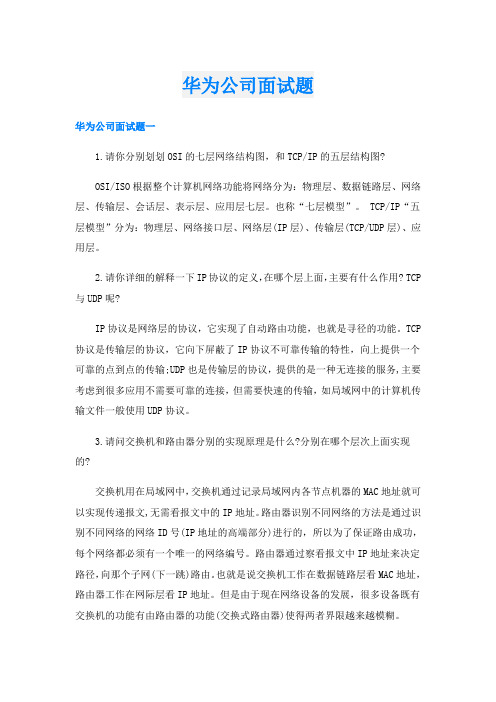
华为公司面试题华为公司面试题一1.请你分别划划OSI的七层网络结构图,和TCP/IP的五层结构图?OSI/ISO根据整个计算机网络功能将网络分为:物理层、数据链路层、网络层、传输层、会话层、表示层、应用层七层。
也称“七层模型”。
TCP/IP“五层模型”分为:物理层、网络接口层、网络层(IP层)、传输层(TCP/UDP层)、应用层。
2.请你详细的解释一下IP协议的定义,在哪个层上面,主要有什么作用? TCP 与UDP呢?IP协议是网络层的协议,它实现了自动路由功能,也就是寻径的功能。
TCP 协议是传输层的协议,它向下屏蔽了IP协议不可靠传输的特性,向上提供一个可靠的点到点的传输;UDP也是传输层的协议,提供的是一种无连接的服务,主要考虑到很多应用不需要可靠的连接,但需要快速的传输,如局域网中的计算机传输文件一般使用UDP协议。
3.请问交换机和路由器分别的实现原理是什么?分别在哪个层次上面实现的?交换机用在局域网中,交换机通过记录局域网内各节点机器的MAC地址就可以实现传递报文,无需看报文中的IP地址。
路由器识别不同网络的方法是通过识别不同网络的网络ID号(IP地址的高端部分)进行的,所以为了保证路由成功,每个网络都必须有一个唯一的网络编号。
路由器通过察看报文中IP地址来决定路径,向那个子网(下一跳)路由。
也就是说交换机工作在数据链路层看MAC地址,路由器工作在网际层看IP地址。
但是由于现在网络设备的发展,很多设备既有交换机的功能有由路由器的功能(交换式路由器)使得两者界限越来越模糊。
4.请问C++的类和C里面的struct有什么区别?C++的class具有数据封装功能,其包含属性访问级别可以为private,public和protect,还具有实现类接口功能和辅助功能的操作函数,而struct属性访问权限只有public,没有数据封装功能,也就没有实现信息隐藏这一面向对象的思想的机制,struct本身不含有操作函数,只有数据。
最新华为面试10题
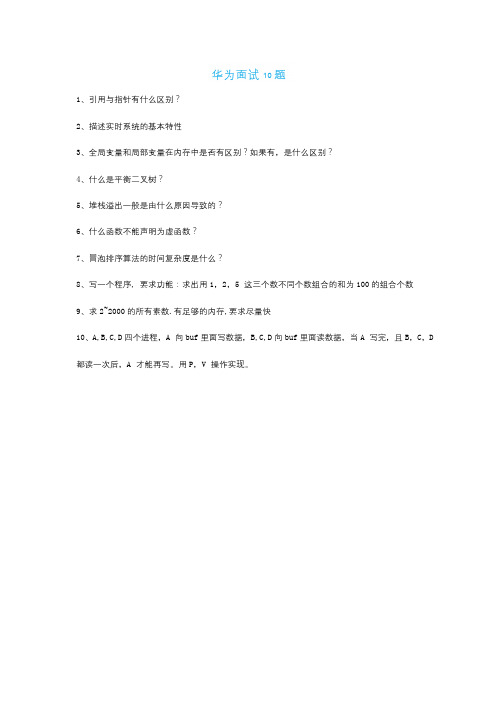
华为面试10 题
1、引用与指针有什么区别?
2、描述实时系统的基本特性
3、全局变量和局部变量在内存中是否有区别?如果有,是什么区别?
4、什么是平衡二叉树?
5、堆栈溢出一般是由什么原因导致的?
6、什么函数不能声明为虚函数?
7、冒泡排序算法的时间复杂度是什么?
8、写一个程序, 要求功能:求出用1,2,5这三个数不同个数组合的和为100的组合个数
9、求2~2000的所有素数.有足够的内存,要求尽量快
10、A,B,C,D四个进程,A向buf里面写数据,B,C,D向buf里面读数据,当A写完,且B,C,D 都读一次后,A才能再写。
用P,V操作实现。
华为常见面试问题有什么_华为常见面试问题及参考答案

华为常见面试问题有什么_华为常见面试问题及参考答案华为是一家业内的大公司,待遇、前景都不错,很多加入华为。
那么华为面试常见的问题有哪些?下面店铺分享了华为常见面试问题及答案,希望你喜欢。
华为面试常见问题【公司篇】1、华为公司的全称为()A、深圳市华为技术有限公司B、华为技术有限公司C、华为公司D、我司(答案:B,答A、C者酌情给分,答D者立即辞退,我司三令五申禁止使用该华为内部土语,屡禁不止,老员工不可教也,只好从新员工抓起,格杀勿论)2、华为公司的企业性质是()A、民营B、私营C、国营D、上市公司(答案:A,本题主要让考生了解公司的性质)3、华为公司的商标象征()A、红太阳B、菊花C、扇贝(答案:B,答A者酌情给分,答C者立即辞退,天天就想着吃)4、从下列选项中选择出公司的常务副总裁()A、任正非B、孙亚芳C、李一男D、郑宝用E、张燕燕(答案:BD,答C者立即辞退,让他到李一男的公司去报到吧)5、华为公司的年终奖一般是在每年的什么时候发()A、元旦后B、春节前C、7月下旬或8月上旬D、劳动节前E、国庆节前(答案:C,切记,因为是年中奖,而不是年终奖)6、华为公司的配给你的股票是()A、**发的B、用自己的奖金去买(答案:B)7、老板常说的土八路,是指()A、老板自己的革命年代的光辉历史B、本地化的用服兄弟C、季度考核为D的兄弟(答案:B)华为面试常见问题【部门篇】1、你所在的一级部门为()A、技术支援部B、国际技术支援部C、国际技术支援部国内分部D、用服(答案:B,答A、C者酌情给分,答D者作不合格处理,为了提高技术支援部形象,公司早就取消用服这个字眼,而且于2001年春节后悄悄地将技术支援部前加“国际”二字)2、你所在的二级部门为()A、传输产品技术支援管理部B、传输工程部C、传输用服工程中心D、光网络产品技术支援管理部(答案:A,首先得把自己的部门搞清楚,答D者,有远见,有潜力,可以酌情给分,很可能在2001年未就改成这个名字,因为市场中研已经改了,就差技术支援部了)3、传输的商标为()A、SBSB、SDHC、OptiXD、Metro(答案:C,答A者酌情给分,最起码还知道老商标)4、技术支援部与国际技术支援部的关系()A、国际技术支援部是技术支援部下面的一个部门,负责海外B、技术支援部是国际技术支援部下面的一个部门,负责国内C、技术支援部是国际技术支援部的前身D、国际技术支援部是技术支援部的前身(答案:C)华为面试常见问题【业务篇】1、SBS是()A、传输产品的老商标B、同步骨干系统C、傻不傻的拼音缩写D、帅不帅的拼音缩写(答案:AB,答CD者立即辞退)2、SDH是()A、传输产品商标B、同步数字序列C、傻得很的拼音缩写D、傻得好的拼音缩写(答案:B,答CD者立即辞退)3、由于你是新员工,没有公配手机时,当你在现场遇到紧急事故时,你会()向公司求助A、打用户机房内的电话B、借用户手机C、拔110D、拔200或300E、立即打车回办事处(答案:D,答CE者立即辞退,按照公司规定,不能随便使用用户的电话,以提高公司形象)4、在开局时,用户问你在华为干几年了,你会回答()A、我是新员工B、1年多了C、2年多了D、3年多了(答案:B,答A者按不合格处理,按照公司规定,不能说自己是新员工,几千万的设备,怎能让一个新员工用来练兵,用户知道鼻子不气歪才怪,答CD者,用户会哼之以鼻,在华为做了2、3年,还在下面撅个腚开局,鬼才相信你的话呢!)5、接上题,假如你回答说在华为干1年多了,用户会说()A、那你一定是新员工了B、那你一定是老员工了(答案:B,用户对华为很了解,都知道你如果在华为做一年,就已经是老员工了)6、接上题及上上题,用户会继续问,“那你咋连手机、便携机,一个都没有呢?”,你会回答()A、啊,我还没有转正咧,等俺转正时,误码仪、手机、便携机,一个都不能少B、啊,没有关系,正是由于我是老员工,所以开局用不着C、啊,真倒霉,在来的路上,被土匪打劫了D、啊,被我的两个徒弟拿走了,因为他们是新员工,没有工具胆小,有了工具好壮胆(答案:BCD,答A者,立即辞退,这么点事都搞不定)7、当你发现用户的机房中没有拖鞋时,你会()A、入乡随俗,直接进机房B、光脚丫C、马上出去自己花钱买几双拖鞋送给用户D、马上出去买几双拖鞋送给用户,之后开票回来贴票报销E、马上出去买几双拖鞋送给用户,之后开票找局长报销(答案:C,答A者,立即辞退,答B者,酌情给分,答D者,不合格处理,答E者,简直是在找死,立即辞退)8、技术支援工程师工作的特点()A、白天睡觉,晚上干活B、用户随叫随到C、用户就是上帝,用户怎么说,我们就怎么做D、我是上帝,我想咋干就咋干(答案:ABC,答D者,立即辞退)9、在与客户开会及纸面件交流时,你会使用()来称呼对方A、局方B、用户C、客户D、贵公司(答案:BCD,答A者,立即辞退,我司三令五申禁止使用该华为内部土语,屡禁不止,老员工不可教也,只好从新员工抓起,格杀勿论)10、工程师甲对乙说:“晚上不去泡吧吗”,乙说:“哦,真不巧,我晚上要去市局割接,下次吧”。
华为常见面试问题及参考答案

华为常见面试问题有什么_华为常见面试问题及参考答案1、华为公司的全称为()A、深圳市华为技术有限公司B、华为技术有限公司C、华为公司D、我司(答案:B,答A、C者酌情给分,答D者立即辞退,我司三令五申禁止使用该华为内部土语,屡禁不止,老员工不可教也,只好从新员工抓起,格杀勿论)2、华为公司的企业性质是()A、民营B、私营C、国营D、上市公司(答案:A,本题主要让考生了解公司的性质)3、华为公司的商标象征()A、红太阳B、菊花C、扇贝(答案:B,答A者酌情给分,答C者立即辞退,天天就想着吃)4、从下列选项中选择出公司的常务副总裁()A、任正非B、孙亚芳C、李一男D、郑宝用E、张燕燕(答案:BD,答C者立即辞退,让他到李一男的公司去报到吧)5、华为公司的年终奖一般是在每年的什么时候发()(答案:C,切记,因为是年中奖,而不是年终奖)A、**发的B、用自己的奖金去买(答案:B)7、老板常说的土八路,是指()B、本地化的用服兄弟(答案:B)1、你所在的一级部门为()A、技术支援部C、国际技术支援部国内分部D、用服(答案:B,答A、C者酌情给分,答D者作不合格处理,为了提高技术支援部形象,公司早就取消用服这个字眼,而且于2001年春节后悄悄地将技术支援部前加“国际”二字)2、你所在的二级部门为()A、传输产品技术支援管理部B、传输工程部C、传输用服工程中心D、光网络产品技术支援管理部(答案:A,首先得把自己的部门搞清楚,答D者,有远见,有潜力,可以酌情给分,很可能在2001年未就改成这个名字,因为市场中研已经改了,就差技术支援部了)3、传输的商标为()A、SBSB、SDHC、OptiXD、Metro(答案:C,答A者酌情给分,最起码还知道老商标)4、技术支援部与国际技术支援部的关系()A、国际技术支援部是技术支援部下面的一个部门,负责海外B、技术支援部是国际技术支援部下面的一个部门,负责国内C、技术支援部是国际技术支援部的前身D、国际技术支援部是技术支援部的前身(答案:C)1、SBS是()A、传输产品的老商标B、同步骨干系统C、傻不傻的拼音缩写D、帅不帅的拼音缩写(答案:AB,答CD者立即辞退)2、SDH是()A、传输产品商标B、同步数字序列C、傻得很的拼音缩写D、傻得好的拼音缩写(答案:B,答CD者立即辞退)3、由于你是新员工,没有公配手机时,当你在现场遇到紧急事故时,你会()向公司求助A、打用户机房内的电话B、借用户手机C、拔110D、拔200或300E、立即打车回办事处(答案:D,答CE者立即辞退,按照公司规定,不能随便使用用户的电话,以提高公司形象)4、在开局时,用户问你在华为干几年了,你会回答()A、我是新员工B、1年多了C、2年多了D、3年多了(答案:B,答A者按不合格处理,按照公司规定,不能说自己是新员工,几千万的设备,怎能让一个新员工用来练兵,用户知道鼻子不气歪才怪,答CD 者,用户会哼之以鼻,在华为做了2、3年,还在下面撅个腚开局,鬼才相信你的话呢!)5、接上题,假如你回答说在华为干1年多了,用户会说()A、那你一定是新员工了B、那你一定是老员工了(答案:B,用户对华为很了解,都知道你如果在华为做一年,就已经是老员工了)6、接上题及上上题,用户会继续问,“那你咋连手机、便携机,一个都没有呢?”,你会回答()A、啊,我还没有转正咧,等俺转正时,误码仪、手机、便携机,一个都不能少B、啊,没有关系,正是由于我是老员工,所以开局用不着C、啊,真倒霉,在来的路上,被土匪打劫了D、啊,被我的两个徒弟拿走了,因为他们是新员工,没有工具胆小,有了工具好壮胆(答案:BCD,答A者,立即辞退,这么点事都搞不定)7、当你发现用户的机房中没有拖鞋时,你会()A、入乡随俗,直接进机房B、光脚丫C、马上出去自己花钱买几双拖鞋送给用户D、马上出去买几双拖鞋送给用户,之后开票回来贴票报销E、马上出去买几双拖鞋送给用户,之后开票找局长报销(答案:C,答A者,立即辞退,答B者,酌情给分,答D者,不合格处理,答E者,简直是在找死,立即辞退)8、技术支援工程师工作的特点()A、白天睡觉,晚上干活B、用户随叫随到C、用户就是上帝,用户怎么说,我们就怎么做D、我是上帝,我想咋干就咋干(答案:ABC,答D者,立即辞退)9、在与客户开会及纸面件交流时,你会使用()来称呼对方A、局方B、用户C、客户D、贵公司(答案:BCD,答A者,立即辞退,我司三令五申禁止使用该华为内部土语,屡禁不止,老员工不可教也,只好从新员工抓起,格杀勿论)10、工程师甲对乙说:“晚上不去泡吧吗”,乙说:“哦,真不巧,我晚上要去市局割接,下次吧”。
华为面试题及答案最新
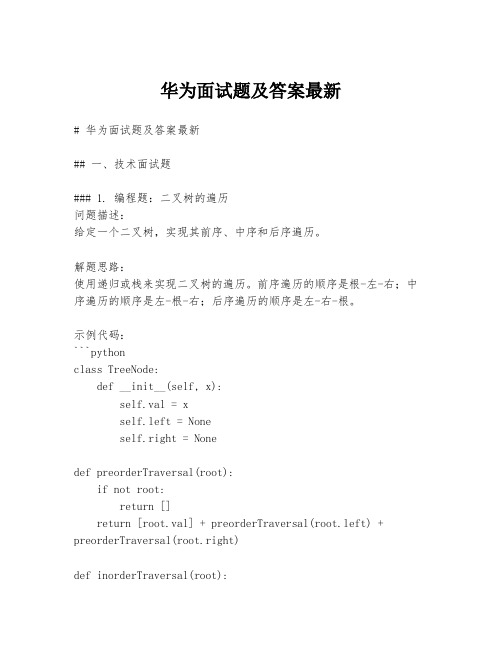
华为面试题及答案最新# 华为面试题及答案最新## 一、技术面试题### 1. 编程题:二叉树的遍历问题描述:给定一个二叉树,实现其前序、中序和后序遍历。
解题思路:使用递归或栈来实现二叉树的遍历。
前序遍历的顺序是根-左-右;中序遍历的顺序是左-根-右;后序遍历的顺序是左-右-根。
示例代码:```pythonclass TreeNode:def __init__(self, x):self.val = xself.left = Noneself.right = Nonedef preorderTraversal(root):if not root:return []return [root.val] + preorderTraversal(root.left) + preorderTraversal(root.right)def inorderTraversal(root):if not root:return []return inorderTraversal(root.left) + [root.val] + inorderTraversal(root.right)def postorderTraversal(root):if not root:return []return postorderTraversal(root.left) + postorderTraversal(root.right) + [root.val]```### 2. 网络题:TCP和UDP的区别问题描述:简述TCP和UDP两种协议的主要区别。
答案要点:- TCP是面向连接的协议,提供可靠的数据传输服务;UDP是无连接的协议,传输速度快但不可靠。
- TCP提供全双工通信,UDP是单向传输。
- TCP有拥塞控制和流量控制机制,UDP没有。
- TCP有数据确认机制,UDP没有。
## 二、非技术面试题### 1. 团队合作问题描述:描述一次你与团队合作解决复杂问题的经历。
华为hr助理面试题目(3篇)

第1篇一、自我介绍1. 请您用3分钟时间,简单介绍一下自己的基本情况,包括教育背景、工作经历、个人兴趣爱好等。
2. 请谈谈您为什么选择从事人力资源管理工作?3. 您认为自己的优势和劣势是什么?二、专业知识与技能1. 请简述您对人力资源六大模块的了解,以及您在哪些模块具有实践经验?2. 请谈谈您对员工招聘、培训、薪酬福利、绩效考核、劳动关系等方面的理解。
3. 请举例说明您在招聘过程中,如何筛选合适的候选人?4. 请谈谈您在培训过程中,如何确保培训效果?5. 请谈谈您在薪酬福利管理中,如何进行薪酬结构设计和福利分配?6. 请谈谈您在绩效考核中,如何进行绩效指标设定和考核方法选择?7. 请谈谈您在劳动关系管理中,如何处理劳动争议和员工关系?三、案例分析1. 案例一:某公司员工离职率高,请分析原因并提出解决方案。
2. 案例二:某公司员工工作积极性不高,请分析原因并提出解决方案。
3. 案例三:某公司面临人才流失问题,请分析原因并提出解决方案。
四、沟通与协作1. 请谈谈您在团队合作中的角色和作用。
2. 请举例说明您如何处理与同事之间的矛盾和冲突。
3. 请谈谈您如何协调上级、同事和下属之间的关系。
4. 请谈谈您在沟通中,如何做到表达清晰、准确、有说服力。
五、应变与解决问题1. 某公司员工因工作压力过大,导致心理问题,请谈谈您如何应对和处理这种情况。
2. 某公司因市场变化,需要进行业务调整,请谈谈您如何协助人力资源部门进行人员调整。
3. 某公司发生重大安全事故,请谈谈您如何协助人力资源部门进行事故调查和处理。
六、职业规划与发展1. 请谈谈您在人力资源管理工作中的职业规划。
2. 您认为自己在人力资源领域有哪些发展方向?3. 请谈谈您如何不断提升自己的专业能力和综合素质。
七、其他问题1. 您对华为公司的了解有多少?2. 您认为华为公司的人力资源管理有哪些优势和不足?3. 您如何看待华为公司的企业文化?4. 您对华为HR助理这个岗位有哪些期待?5. 您在未来的工作中,如何保持学习和进步?6. 您认为自己在面对困难时,如何调整心态和应对?7. 您如何看待加班和出差?8. 您在团队合作中,如何处理个人利益与团队利益的关系?9. 您如何看待职业发展与个人生活之间的平衡?10. 您在未来的工作中,如何保持积极的心态和敬业精神?以上题目仅供参考,实际面试过程中,面试官可能会根据应聘者的具体情况进行调整。
华为普工面试题及答案

华为普工面试题及答案一、华为普工面试题1. 你为什么选择申请华为普工职位?2. 你对华为有什么了解?3. 你认为普工职位需要具备什么样的技能和素质?4. 描述一下你在之前的工作中遇到的一个挑战,并且如何解决的?5. 你在团队合作中的角色是什么?6. 你在高压工作环境下的应对方法是什么?7. 如何处理工作中的错误及不满?二、华为普工面试题答案1. 我选择申请华为普工职位是因为我对华为这个公司非常有信心。
我知道华为是一家世界知名的科技公司,拥有强大的研发实力和丰富的市场资源。
同时,华为也非常重视员工的职业发展和个人成长,给予员工广阔的发展空间。
2. 我对华为有很多了解。
华为成立于1987年,是一家以研发、生产和销售电信设备为主的全球领先的信息与通信技术(ICT)解决方案供应商。
华为专注于ICT领域,主要产品和服务包括无线网络、有线网络、终端设备和云计算解决方案等。
3. 普工职位需要具备一定的技能和素质。
首先,具备良好的工作纪律和遵守规章制度的能力。
其次,具备基本的技术操作能力和工作经验,能够熟练使用相关工具和设备。
此外,团队合作和沟通能力也是普工职位所需要的。
4. 之前我在一家制造公司工作时,遇到了一个产线连续故障的挑战。
我首先与同事一起仔细检查设备,发现了故障的原因。
然后,我立即与维修人员联系,并协助他们迅速解决了问题。
最后,我提出了一些建议,帮助公司预防类似故障的发生。
5. 在团队合作中,我的角色是积极参与者和协调者。
我注重团队的凝聚力和共同目标,会与同事密切合作,互相支持和帮助。
同时,我也能够积极协调团队内部的工作,确保任务按时完成。
6. 在高压工作环境下,我会保持冷静和沉稳,并且合理分配和安排工作。
我会把工作任务分解成小的目标,并制定相应的计划和时间表。
同时,我也会适时地调整自己的工作节奏,以保证自己的体力和精力。
7. 当遇到错误和不满时,我会首先冷静分析问题的原因,并制定解决方案。
然后,我会与相关人员进行沟通,积极寻求解决办法。
华为常考面试题及答案解析

华为常考面试题及答案解析1. 请介绍一下华为公司的发展历程。
华为公司成立于1987年,是一家全球领先的ICT解决方案供应商。
公司起初专注于通信设备的制造和销售,随着市场的发展,逐渐扩展到电信网络、企业网络、消费者业务等多个领域。
华为在全球范围内建立了广泛的合作伙伴网络,为全球客户提供高质量的产品和服务。
2. 请介绍一下华为公司的核心竞争力。
华为公司的核心竞争力主要体现在以下几个方面:- 技术创新能力:华为在ICT领域拥有强大的技术研发实力,持续推动技术创新,不断推出具有竞争力的产品和解决方案。
- 全球化运营能力:华为在全球范围内建立了完善的销售和服务网络,能够快速响应客户需求,提供定制化的解决方案。
- 人才优势:华为高度重视人才培养和引进,拥有一支专业素质高、经验丰富的团队,为公司的发展提供了强大支持。
- 业务多元化:华为业务涵盖了电信网络、企业网络、消费者业务等多个领域,实现了多元化的业务发展,降低了市场风险。
3. 请谈谈你对5G技术的理解和应用前景。
5G技术是第五代移动通信技术,具有更高的速度、更低的延迟和更大的连接密度。
它将为各行各业带来巨大的变革和机遇。
在应用前景方面,5G技术将广泛应用于智能制造、智慧城市、智能交通、物联网等领域。
它将加速工业自动化和数字化转型,提升生产效率和产品质量;改善城市管理和公共服务,提升城市运行效率和居民生活质量;实现车联网和智能交通系统,提高交通安全和交通效率;连接更多的物联网设备,实现智能家居、智慧医疗等应用。
总之,5G技术将为人们的生活和工作带来更多便利和可能性。
4. 请谈谈你对人工智能的理解和应用前景。
人工智能是一门研究如何使计算机具有智能的学科。
它通过模拟人类的智能行为和思维过程,实现了诸如语音识别、图像识别、自然语言处理等功能。
在应用前景方面,人工智能具有广泛的应用前景。
它可以应用于医疗健康、金融、智能交通、智能制造等多个领域。
例如,在医疗领域,人工智能可以辅助医生进行疾病诊断和治疗方案选择;在金融领域,人工智能可以实现风险评估和智能投资;在智能交通领域,人工智能可以实现智能驾驶和交通管理。
华为面试题 (3)

华为面试题华为是一家世界知名的通信技术公司,常常被誉为中国的骄傲。
由于其强大的技术实力和对人才的重视,华为在招聘过程中也提出了一系列挑战性的面试题。
本文将介绍一些常见的华为面试题,并为您提供参考答案。
题目一:谈谈对华为文化的理解华为一直以来都强调“以客户为中心”的文化理念,这也是他们取得成功的关键之一。
面试官关心的是你对华为文化的理解,你是否能够融入华为的价值观,以及如何将其体现在工作中。
参考答案:华为文化是指在华为公司内部形成的一套共同的价值观和行为准则。
华为文化的核心是“以客户为中心”。
这意味着在工作中,我们要时刻关注客户的需求,提供满足客户期望的产品和服务。
此外,华为文化还强调创新、结果导向和团队合作。
在华为,员工被鼓励提出新想法和创新解决方案,以不断追求更好的结果。
同时,团队合作也是华为文化的重要方面,员工需要在团队中相互支持、协作,共同实现目标。
题目二:举例说明你在工作中如何解决难题这个问题考察的是你的问题解决能力和应变能力,华为是一个充满挑战和竞争的工作环境,因此能够快速解决问题并采取有效措施是非常重要的。
参考答案:在我之前的工作中,我曾遇到一个项目进度延误的问题。
为了解决这个问题,我首先分析了延误的原因,并与项目组成员进行了讨论。
通过分析,我们发现问题是由于沟通不畅导致的。
为了解决这个问题,我主动和项目组进行沟通,推动团队成员间的信息共享和合作。
同时,我还针对项目计划进行了调整,重新分配工作量,以便保证项目能够按时完成。
最终,我们通过共同努力解决了延误问题,并按时交付了项目。
题目三:谈谈你对5G技术的理解和应用华为是全球领先的5G技术提供商之一,他们希望招聘具备相关知识和理解的候选人。
这个问题是考察你对5G技术的了解程度以及对其应用的认识。
参考答案:5G技术是第五代移动通信技术的简称,具备更高的传输速度、更低的延迟和更大的容量。
它将在许多领域得到应用,包括智能交通、远程医疗、工业物联网等。
华为面试中的常见问题及其解答

华为面试中的常见问题及其解答华为作为中国乃至全球领先的通信技术公司,其面试过程严谨而专业。
以下为华为面试中常见的问题及其解答,希望能帮助求职者更好地准备面试。
个人背景相关问题1: 请简单介绍一下你自己。
请简单介绍一下你自己。
解答: 请突出你的教育背景、工作经验和个人特长,并强调为什么你想加入华为。
请突出你的教育背景、工作经验和个人特长,并强调为什么你想加入华为。
问题2: 你为什么选择华为?你为什么选择华为?解答: 表达你对华为的企业文化、价值观、产品或技术的认同,以及你希望在这些领域中发挥的作用。
表达你对华为的企业文化、价值观、产品或技术的认同,以及你希望在这些领域中发挥的作用。
专业技能相关问题3: 请谈谈你在XX领域的经验。
请谈谈你在XX领域的经验。
解答: 具体描述你在该领域的项目经验、技术能力、解决问题的方式等。
具体描述你在该领域的项目经验、技术能力、解决问题的方式等。
问题4: 你如何看待XX技术的发展趋势?你如何看待XX技术的发展趋势?解答: 展示你对行业动态的关注,并提供你对技术发展趋势的看法。
展示你对行业动态的关注,并提供你对技术发展趋势的看法。
工作经历相关问题5: 在你之前的工作中,遇到的最大挑战是什么?在你之前的工作中,遇到的最大挑战是什么?解答: 讲述一个具体案例,说明你如何应对挑战并取得成功。
讲述一个具体案例,说明你如何应对挑战并取得成功。
问题6: 你如何看待团队合作?你如何看待团队合作?解答: 强调你在团队合作中的积极表现,以及你如何与团队成员有效沟通和协作。
强调你在团队合作中的积极表现,以及你如何与团队成员有效沟通和协作。
情景模拟问题7: 假设你在项目中遇到了技术难题,你会如何解决?假设你在项目中遇到了技术难题,你会如何解决?解答: 描述你的问题解决流程,包括分析问题、寻求帮助、尝试解决方案等。
描述你的问题解决流程,包括分析问题、寻求帮助、尝试解决方案等。
问题8: 如果你被分配了一个你不太熟悉的项目,你会怎么做?如果你被分配了一个你不太熟悉的项目,你会怎么做?解答: 展示你的研究能力和适应性,描述你如何快速掌握新知识和技能。
华为招聘面试题精选
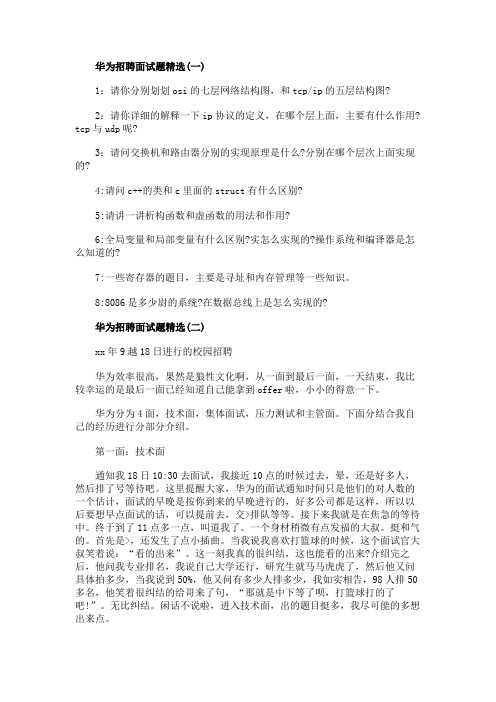
华为招聘面试题精选(一)1:请你分别划划osi的七层网络结构图,和tcp/ip的五层结构图?2:请你详细的解释一下ip协议的定义,在哪个层上面,主要有什么作用? tcp与udp呢?3:请问交换机和路由器分别的实现原理是什么?分别在哪个层次上面实现的?4:请问c++的类和c里面的struct有什么区别?5:请讲一讲析构函数和虚函数的用法和作用?6:全局变量和局部变量有什么区别?实怎么实现的?操作系统和编译器是怎么知道的?7:一些寄存器的题目,主要是寻址和内存管理等一些知识。
8:8086是多少尉的系统?在数据总线上是怎么实现的?华为招聘面试题精选(二)xx年9越18日进行的校园招聘华为效率很高,果然是狼性文化啊,从一面到最后一面,一天结束,我比较幸运的是最后一面已经知道自己能拿到offer啦,小小的得意一下。
华为分为4面,技术面,集体面试,压力测试和主管面。
下面分结合我自己的经历进行分部分介绍。
第一面:技术面通知我18日10:30去面试,我接近10点的时候过去,晕,还是好多人,然后排了号等待吧。
这里提醒大家,华为的面试通知时间只是他们的对人数的一个估计,面试的早晚是按你到来的早晚进行的,好多公司都是这样,所以以后要想早点面试的话,可以提前去,交>排队等等。
接下来我就是在焦急的等待中。
终于到了11点多一点,叫道我了。
一个身材稍微有点发福的大叔。
挺和气的。
首先是>,还发生了点小插曲。
当我说我喜欢打篮球的时候,这个面试官大叔笑着说:“看的出来”。
这一刻我真的很纠结,这也能看的出来?介绍完之后,他问我专业排名,我说自己大学还行,研究生就马马虎虎了,然后他又问具体拍多少,当我说到50%,他又问有多少人排多少,我如实相告,98人排50多名,他笑着很纠结的给哥来了句,“那就是中下等了呗,打篮球打的了吧!”。
无比纠结。
闲话不说啦,进入技术面,出的题目挺多,我尽可能的多想出来点。
指向指针的指针的用法,作用双向链表节点的删除冒泡排序(蛋疼,唯一答错的一道题,我把冒泡和选择整混了,我还一直坚持我的意见,我还引导他,后来,我引导到最后发现,我错了,好尴尬。
华为常见面试问题有什么_华为常见面试问题及参考答案.doc

华为常见面试问题有什么_华为常见面试问题及参考答案华为是一家业内的大公司,待遇、前景都不错,很多加入华为。
那么华为面试常见的问题有哪些?下面分享了华为常见面试问题及答案,希望你喜欢。
华为面试常见问题【公司篇】1、华为公司的全称为()A、深圳市华为技术有限公司B、华为技术有限公司C、华为公司D、我司(答案:B,答A、C者酌情给分,答D者立即辞退,我司三令五申禁止使用该华为内部土语,屡禁不止,老员工不可教也,只好从新员工抓起,格杀勿论)2、华为公司的企业性质是()A、民营B、私营C、国营D、上市公司(答案:A,本题主要让考生了解公司的性质)3、华为公司的商标象征()A、红太阳B、菊花C、扇贝(答案:B,答A者酌情给分,答C者立即辞退,天天就想着吃)4、从下列选项中选择出公司的常务副总裁()A、任正非B、孙亚芳C、李一男D、郑宝用E、张燕燕(答案:BD,答C者立即辞退,让他到李一男的公司去报到吧)5、华为公司的年终奖一般是在每年的什么时候发()A、元旦后B、春节前C、7月下旬或8月上旬D、劳动节前E、国庆节前(答案:C,切记,因为是年中奖,而不是年终奖)6、华为公司的配给你的股票是()A、**发的B、用自己的奖金去买(答案:B)7、老板常说的土八路,是指()A、老板自己的革命年代的光辉历史B、本地化的用服兄弟C、季度考核为D的兄弟(答案:B)华为面试常见问题【部门篇】1、你所在的一级部门为()A、技术支援部B、国际技术支援部C、国际技术支援部国内分部D、用服(答案:B,答A、C者酌情给分,答D者作不合格处理,为了提高技术支援部形象,公司早就取消用服这个字眼,而且于2001年春节后悄悄地将技术支援部前加国际二字)2、你所在的二级部门为()A、传输产品技术支援管理部B、传输工程部C、传输用服工程中心D、光网络产品技术支援管理部(答案:A,首先得把自己的部门搞清楚,答D者,有远见,有潜力,可以酌情给分,很可能在2001年未就改成这个名字,因为市场中研已经改了,就差技术支援部了)3、传输的商标为()A、SBSB、SDHC、OptiXD、Metro(答案:C,答A者酌情给分,最起码还知道老商标)4、技术支援部与国际技术支援部的关系()A、国际技术支援部是技术支援部下面的一个部门,负责海外B、技术支援部是国际技术支援部下面的一个部门,负责国内C、技术支援部是国际技术支援部的前身D、国际技术支援部是技术支援部的前身(答案:C)华为面试常见问题【业务篇】1、SBS是()A、传输产品的老商标B、同步骨干系统C、傻不傻的拼音缩写D、帅不帅的拼音缩写(答案:AB,答CD者立即辞退)2、SDH是()A、传输产品商标B、同步数字序列C、傻得很的拼音缩写D、傻得好的拼音缩写(答案:B,答CD者立即辞退)3、由于你是新员工,没有公配手机时,当你在现场遇到紧急事故时,你会()向公司求助A、打用户机房内的电话B、借用户手机C、拔110D、拔200或300E、立即打车回办事处(答案:D,答CE者立即辞退,按照公司规定,不能随便使用用户的电话,以提高公司形象)4、在开局时,用户问你在华为干几年了,你会回答()A、我是新员工B、1年多了C、2年多了D、3年多了(答案:B,答A者按不合格处理,按照公司规定,不能说自己是新员工,几千万的设备,怎能让一个新员工用来练兵,用户知道鼻子不气歪才怪,答CD者,用户会哼之以鼻,在华为做了2、3年,还在下面撅个腚开局,鬼才相信你的话呢!)5、接上题,假如你回答说在华为干1年多了,用户会说()A、那你一定是新员工了B、那你一定是老员工了(答案:B,用户对华为很了解,都知道你如果在华为做一年,就已经是老员工了)6、接上题及上上题,用户会继续问,那你咋连手机、便携机,一个都没有呢? ,你会回答()A、啊,我还没有转正咧,等俺转正时,误码仪、手机、便携机,一个都不能少B、啊,没有关系,正是由于我是老员工,所以开局用不着C、啊,真倒霉,在来的路上,被土匪打劫了D、啊,被我的两个徒弟拿走了,因为他们是新员工,没有工具胆小,有了工具好壮胆(答案:BCD,答A者,立即辞退,这么点事都搞不定)7、当你发现用户的机房中没有拖鞋时,你会()A、入乡随俗,直接进机房B、光脚丫C、马上出去自己花钱买几双拖鞋送给用户D、马上出去买几双拖鞋送给用户,之后开票回来贴票报销E、马上出去买几双拖鞋送给用户,之后开票找局长报销(答案:C,答A者,立即辞退,答B者,酌情给分,答D 者,不合格处理,答E者,简直是在找死,立即辞退)8、技术支援工程师工作的特点()A、白天睡觉,晚上干活B、用户随叫随到C、用户就是上帝,用户怎么说,我们就怎么做D、我是上帝,我想咋干就咋干(答案:ABC,答D者,立即辞退)9、在与客户开会及纸面件交流时,你会使用()来称呼对方A、局方B、用户C、客户D、贵公司(答案:BCD,答A者,立即辞退,我司三令五申禁止使用该华为内部土语,屡禁不止,老员工不可教也,只好从新员工抓起,格杀勿论)10、工程师甲对乙说:晚上不去泡吧吗,乙说:哦,真不巧,我晚上要去市局割接,下次吧。
华为面试题(附答案)
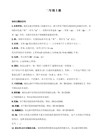
对于同时能够使用几个进程进行查询或操作的大型表分区非常有用
alter table table_name truncate partition partition_name;
6、 物理文件有哪几种?控制文件包含了什么信息?
1) 数据文件 2)控制文件 3)日志文件
包含维护和验证有选举权据库完整性的必要信息、例如,控制文件用于识别数据文件和重做日志文件,一个有选举权据库至少需要一个控制文件
7、 表空间用完了如何增加?
三种种扩展方式:
1 增加数据文件 alter tablespace name add datafile ‘路径’ size 4M;
2 扩展数据文件大小alter database datafile ‘路径’ resize 4M;
15、 你对游标的理解,游标的分类,使用方法?
游标是结果集数据中的指针,作用是为遍历结果集时,存储每条记录的结果,
1.声明游标,2.打开游标,3.提取游标,4.关闭游标
游标for循环
显式游标,隐式游标,游标变量!
16、 存储过程的用法?在存储过程中异常的处理,分类?举两个预定义异常的例子?
SQL> create index dinya_idx_t on dinya_test(item_id);
Index created.
SQL>
同样的,对全局索引根据执行计划可以看出索引已经可以使用:
SQL> select * from dinya_test t where t.item_id=12;
2 global partition by range(item_id)
- 1、下载文档前请自行甄别文档内容的完整性,平台不提供额外的编辑、内容补充、找答案等附加服务。
- 2、"仅部分预览"的文档,不可在线预览部分如存在完整性等问题,可反馈申请退款(可完整预览的文档不适用该条件!)。
- 3、如文档侵犯您的权益,请联系客服反馈,我们会尽快为您处理(人工客服工作时间:9:00-18:30)。
华为公司 java 面试题
第一部分:选择题
QUESTION NO: 1
1、public class Test {
public static void changeStr(String str){
str='welcome';
}
public static void main(String[] args) {
String str='1234';
changeStr(str);
}
}
Please write the output result :welcome
QUESTION NO:2
1. public class Test {
2. static boolean foo(char c) {
3.
4. return true;
5. }
6. public static void main( String[] argv ) {
7. int i =0;
8. for ( foo('A'); foo('B')&&(i<2); foo('C')){
9. i++ ;
10. foo('D');
12. }
13. }
14. }
What is the result? A
A. ABDCBDCB
B. ABCDABCD
C. Compilation fails.
D. An exception is thrown at runtime.
QUESTION NO: 3
1. class A {
2. protected int method1(int a, int b) { return 0; }
3. }
Which two are valid in a class that extends class A? (Choose two) b
A. public int method1(int a, int b) { return 0; }
B. private int method1(int a, int b) { return 0; }
C. private int method1(int a, long b) { return 0; }
D. public short method1(int a, int b) { return 0; }
E. static protected int method1(int a, int b) { return 0; }
QUESTION NO: 4 d
1. public class Outer{
2. public void someOuterMethod() {
3. }
5. public class Inner{}
6. public static void main( String[]argv ) {
7. Outer o = new Outer();
8. }
10. }
Which instantiates an instance of Inner?
A. new Inner(); new Inner(); 8
new (); new (); ew Inner()
QUESTION NO: 5
Which method is used by a servlet to place its session ID in a URL th at is written to the servlet’s response output stream? d
A. The encodeURL method of the HttpServletRequest interface.
B. The encodeURL method of the HttpServletResponse interface.
C. The rewriteURL method of the HttpServletRequest interface.
D. The rewriteURL method of the HttpServletResponse interface.
QUESTION NO: 6
Which two are equivalent? (Choose two)
A. <%= %>
B. <%= ()%>
C. <%= ('size')%>
D. <jsp:getProperty id='YoshiBean' param='size'/>
E. <jsp:getProperty name='YoshiBean' param='size'/>
F. <jsp:getProperty id='YoshiBean' property='size'/>
G. <jsp:getProperty name='YoshiBean' property='size'/>
QUESTION NO: 7
Which of the following statements regarding the lifecycle of a sessio n bean are correct?
1. is thrown if () is invoked when a stateful session bean instanc
e is passivated.
2. () does not throw an exception when a session bean with bean-man aged transaction demarcation is activated.
3. An exception is not thrown when () is called in the afterBegin m ethod of a bean with container-managed transactions.
4. JNDI access to java:comp/env is permitted in all the SessionSync hronization methods of a stateful session bean with container-managed
transaction demarcation.
5. Accessing resource managers in the method of a stateful session bean with bean-managed transaction does not throw an exception.
第二部分:概念题
1.描述Struts体系结构?对应各个部分的开发工作主要包括哪些?2. XML包括哪些解释技术,区别是什么?
3. JSP有哪些内置对象和动作?它们的作用分别是什么?
4、SQL问答题
SELECT * FROM TABLE
和
SELECT * FROM TABLE
WHERE NAME LIKE '%%' AND ADDR LIKE '%%'
AND (1_ADDR LIKE '%%' OR 2_ADDR LIKE '%%'
OR 3_ADDR LIKE '%%' OR 4_ADDR LIKE '%%' )
的检索结果为何不同?
5、SQL问答题
表结构:
1、表名:g_cardapply
字段(字段名/类型/长度):
g_applyno varchar 8;//申请单号(关键字)
g_applydate bigint 8;//申请日期
g_state varchar 2;//申请状态
2、表名:g_cardapplydetail
字段(字段名/类型/长度):
g_applyno varchar 8;//申请单号(关键字)
g_name varchar 30;//申请人姓名
g_idcard varchar 18;//申请人身份证号
g_state varchar 2;//申请状态
其中,两个表的关联字段为申请单号。
题目:
1、查询身份证号码为0103082的申请日期
Select g_applydate from g_cardapply where g_idcarda=0103082
2、查询同一个身份证号码有两条以上记录的身份证号码及记录个数
3、将身份证号码为0103082的记录在两个表中的申请状态均改为07
4、删除g_cardapplydetail表中所有姓李的记录。
